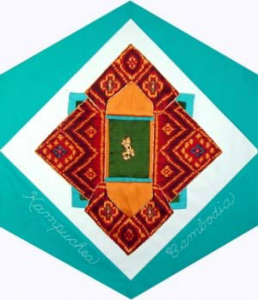Cambodia

The Block
Handwoven silk inspires blockmaker Sophal Tan Tuok’s passion. The ikat woven background, in a traditional pattern, is cut into shapes reminiscent of the architecture of Cambodia’s temples. The pieces are outlined in gold thread, commonly woven throughout women’s sampots (skirts). Ikat is a style of weaving in which each strand of silk is individually dyed and then woven into vibrant designs which are recognized from village to village. The natural movement during the weaving process gives the designs a feathered edge, characteristic of this technique.
A gold apsaras dancer pin, symbolic of the country’s strong dance tradition, sits at the centre of the Cambodia block. Classical dance in Cambodia is highly stylized and involves slow, controlled, and graceful movements. The apsaras, named after the female spirits of nature who loved to dance and were said to do so often for the gods, is performed by barefooted girls wearing golden headdresses and embroidered silk costumes worn so tightly that the dancers must be sewn into them before each performance.
Cultural Profile
Cambodia, once called Kampuchea, is located in Southeast Asia a short distance north of the equator. It is home to the celebrated temples of Angkor Wat. Famous for their size and intricate architecture, the temples once contained statues of gold and bronze and were decorated with many carvings. After being abandoned in the 15th century, the jungle gradually grew over the buildings and the site was only rediscovered in 1861 by French naturalist, Henri Mouhot.
Ethnic Khmers form the largest part of Cambodia’s population, which is also comprised of Chinese and Vietnamese groups. The official language is Khmer, although English and French are also spoken. Small communities of Chinese and Vietnamese speak their own languages as well. Cambodians traditionally greet each other with a Sompeah, a gesture that involves pressing their hands together in front of their bodies and bowing; however, handshakes are becoming more acceptable as a salutation.
Cambodia experiences an unusual process of water reversal during which water flows from the Tonle Sap (Great Lake) through a channel into the Mekong River (the world’s tenth longest) or vice-versa, depending on the season. This occurrence –– celebrated annually with a three-day festival –– is helpful to farmers and fishermen since, in the dry seasons, the shrunken lake leaves behind fertilized ground for growing crops and, during the wet times, the swollen lake is home to abundant freshwater fish. Houses in Cambodian cities are similar to those in other countries. However, rural houses are built on stilts because of the monsoons that bring heavy rain. Entire villages are built on boats in order to protect the buildings from a 7 meter rise in the waters between the dry and wet seasons. Some of the bigger villages have their own floating churches, hospitals, gas stations, and even karaoke bars.
During years of hardship and war, Cambodia’s culture was almost destroyed, however many of the country’s traditional arts are now seeing a revival. These include textiles, silverwork, woodcarving, stone sculpture, painting, metal work and weaving. Mat weaving, using brightly coloured reeds and jute, is done in many provinces of the country. The traditional pottery technique of bashing the clay, instead of using a potter wheel, is also a distinctive craft of the country. Potters use a large wooden stick adorned with carvings to bash the pots into shape, leaving designs in the clay.
Mulberry trees are being replanted in Cambodia and the silk industry is recovering, sparking hope that Cambodian silk weavers will be able to use more local silk in the future. Uneven twill, where one or two colours are used, and ikat are the two most common silk weaving techniques in the country. The traditional dress of Cambodians displays the ability of individual weavers. The sampot, the long wrap skirt worn by both women and men, is usually made of locally-produced silk and features a wide variety of patterns.
The Royal Ballet of Cambodia, with its dazzling and richly ornamented costumes and crowns indicating the social rank of the dancer, is probably the best known tradition of Cambodia worldwide. The Sbek Thom, the traditional Khmer shadow theatre, also continues to delight old and young, Cambodians and outsiders alike.
Immigration records indicate that Cambodians have been coming to Canada since the 1980s. Business people and students came at first, settling in Ontario, Quebec, Alberta and British Columbia. However many others have come as refugees during the later years of the 1970’s, fleeing brutal oppression in their homeland. There are approximately 34,000 Cambodians now living in Canada.
Sponsor: Nancy Warwick
